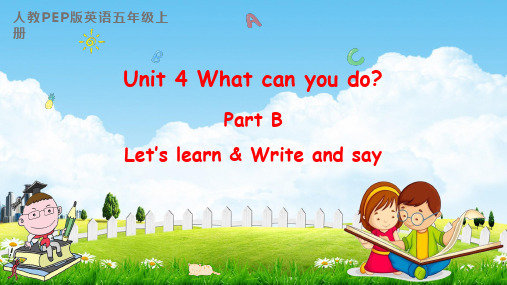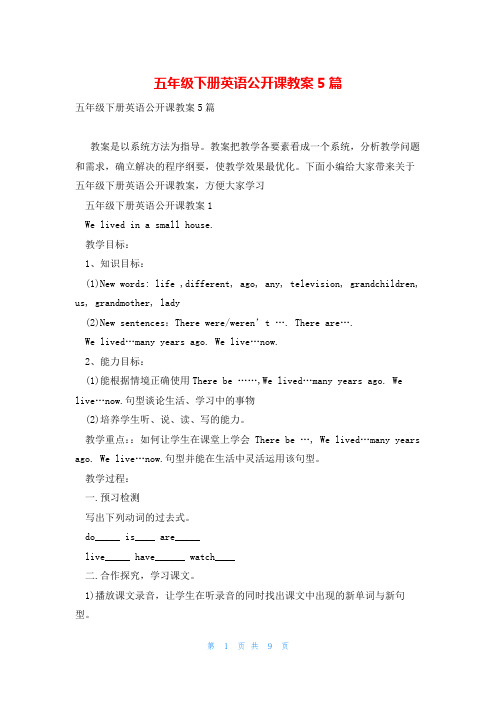小学英语五年级微课
五年级上册英语Unit3would like用法小结微课公开课课件优质PPT

“w like 在变否定句的时候直接在would后面加上not。
e.g. I would not like to go to Shanghai. Tom would not like those old books.
“would like”用法小结
想吃点什么?
想喝点什么?
I’d like to read this book in the park.
想要(去做某事)
“would like”用法小结
创新微课
巩固操练
1. I would like some oranges.(变一般疑问句) Would ______ you _______ like some oranges? _______
创新微课
知识讲解 I would like… 在变一般疑问句的时候,应该将would提前。
e.g. Would you like some paper? Would you like to have a rest(休息)?
肯定和否定回答:Yes, I’d like to. /Sorry, I can’t.
同学,下节再见
“would like”用法小结
“would like”用法小结
创新微课
“would like”用法小结
创新微课
知识讲解
would like 表示“想要”的意思,用来表达人的意愿或者需求。
e.g. I would like some pencils.
What would you like? would经常与主语缩写成’d. e.g. She’d like an egg. I’d like some books.
2. Would you like to help me?(肯定回答)
小学英语微课设计教案5篇

小学英语微课设计教案5篇小学英语微课设计教案篇1一、教学目标学问目标:1. 学会使用句型“What did you do at the weekend?”和“Where did you go?”并懂得使用相应的过去式进行对话。
2. 能有感情地朗读课文,并进行角色扮演。
3. 能用动词过去式询问上周末的活动情况。
能力目标:1.会用“What did you do at the weekend?”和“Where did you go?”询问过去发生的事情。
2.通过活动体验,在交流中学会谈论上周末从事的活动,谈论不久前发生的事情,发展综合语言运用能力。
提高学生跨文化交际意识。
情感目标:培养学生学习兴趣,鼓励学生乐观合作,引导学生了解西方文化古迹,树立旅游意识。
二、教学重点与难点教学重点:1. 能听懂、会说并能熟练使用单词weekend, place, trip, along, river, twenty, minute, hour, best以及词组the British Museum, bus ride.2. 能听懂、会说并能熟练使用句子What did you do at the weekend? 和Where did you go?教学难点:能够在真实情境中对单词、词汇及句型进行综合的运用。
三、教学方法1. 通过老师引导示范,学生自主识记,小组合作,朗读合作等多种形式,使学生读懂文章并把握重难句的实际运用。
2. 通过两两对话提高学生学习英语策略及口语交际能力。
3. 通过“争当小记者”活动激发并保持学生学习英语兴趣。
四、教学预备课件,Flash视频,词卡,Daming和Amy头像,记者证五、教学过程Step1: Warming-up1) Greet to the students.2) Listen a song“Where did you go?”唱关于旅游的歌曲,为新课做铺垫。
Step2: Lead-in1)老师出示自己的旅游照。
小学英语新版人教版(PEP)五年级上册Unit1 What's he like PartB课件

Let’s learn
• • • • • shy 羞怯的;腼腆的; helpful 有用的,愿意帮忙的 clever 聪明的 hard-working 工作努力的;辛勤的 polite 有礼貌的;客气的
• Tian Tian is my good friend. He is a boy. He is _______.He is_______. He is _______. I like him.(我喜欢他。)
The baby is so cute(可爱). But he is very
shy.
Do you know her?
你认识她吗?
What’s she like?
她是怎样的人?
She’s helpful.
她很有用。
What’s she like?
她是怎样的人?
She’s funny.
Is she clever? Yes, she is. No, she isn’t.
连词成句:
Exercises:
Is, funny, she ( ? ) ____________________________ Is she funny? and, she, thin, is, short ( . ) ____________________________ She is thin and short. like, is, he, what ( ? ) ____________________________ What is he like? English, your, teacher, is, who ( ? ) ____________________________ Who is your English teacher?
人教PEP版五年级英语上册《Unit 4 Part B 第二课时》教学课件优秀公开课

Can
Can’t
音形匹配:随机点击声音,找到相应的卡片后读单词。
5 3 1
2
4
Exercises
( C ) 1. —
can you do?
—I can sing.
A. Who
B. How
C. What
( A ) 2.
you do kung fu?
A. Can
B. Are
C. can’t
( C ) 3. —Can Sarah speak Chinese?
人教PEP版英语五年级上 册
Unit 4 What can you do?
Part B Let’s learn & Write and say
Warm up
Sing a song: What can you do?
Lead in
What other activities can
you do?
cook+
do some kung fu+
draw cartoons+
sing English songs+
Presentation
Can you play ping-pong?
Yes, I can.
play+球类
Can you play basketball?
Yes, I can.
Can he swim? Yes, he can.
Write and say
Can
speak English and Chinese sing English songs dance and swim cook play ping-pong
Can’t
五年级下册英语公开课教案5篇

五年级下册英语公开课教案5篇五年级下册英语公开课教案5篇教案是以系统方法为指导。
教案把教学各要素看成一个系统,分析教学问题和需求,确立解决的程序纲要,使教学效果最优化。
下面小编给大家带来关于五年级下册英语公开课教案,方便大家学习五年级下册英语公开课教案1We lived in a small house.教学目标:1、知识目标:(1)New words: life ,different, ago, any, television, grandchildren, us, grandmother, lady(2)New sentences:There were/weren’t …. There are….We lived…many years ago. We live…now.2、能力目标:(1)能根据情境正确使用There be ……,We lived…many years ago. Weliv e…now.句型谈论生活、学习中的事物(2)培养学生听、说、读、写的能力。
教学重点::如何让学生在课堂上学会There be …, We lived…many years ago. We live…now.句型并能在生活中灵活运用该句型。
教学过程:一.预习检测写出下列动词的过去式。
do_____ is____ are_____live_____ have______ watch____二.合作探究,学习课文。
1)播放课文录音,让学生在听录音的同时找出课文中出现的新单词与新句型。
2)进行游戏“火眼金睛找生词新句”。
让学生以竞赛抢答的形式快速找出课文中出现的新单词与新句型。
3)在让学生初步了解了课文内容后,教师再次播放录音,让学生大声跟读课文。
巩固练习;重点句式操练Listen and say。
先让学生听录音,跟读句子,明确本课的重点句式,然后让他们灵活运用句式:There is/are……/There was/were……造句。
小学英语(五年级)5.微课设计Preparing for the trip.

T: My passport, my visa, my sun-glasses…
T: Yes, I am going to have a trip, but I don’t know if I am ready for the trip. Can you help me? (First, you can discuss in your group.)
教学目标
1.学生通过课文文本“Grandma帮助Daming确定他的旅行准备”的学习,复习并巩固“What…? Where…? When…? Who…? How…?”等特殊疑问句。
2.学生能运用“What…? Where…? When…? Who…? How…?”等特殊疑问句来帮助老师及同伴做旅行准备。
S1:How will you get there?
T: That’s a good question. How will Daming get there?Do you know?
Ss: By plane.
1分钟
2.To help Ms Xu prepare for the trip.
T: Look, this is my bag. I am going to have a trip this summer. What did I put in my bag? Do you know?
2.通过本微课教师能了解在任务型教学模式下如何运用真实的任务活动进行任务的准备。
30秒以内
2、正文讲解
(6分钟左右)
T: Daming is going to go toAmerica, but he is not sure about his trip, so Grandma helps him. What did Grandma ask? Do you remember?
小学英语微课ppt课件

04
Teaching method
BIG DATA EMPOWERS TO CREATE A NEW
ERA
Interactive teaching
Teacher student interaction
Teachers guide students to actively participate in the classroom and improve classroom interactivity through questioning, group discussions, and other methods.
Basic Grammar
Summary
Mastering basic grammar knowledge
Detailed description
Learn basic sentence structure and part of speech, understand the usage of tense, voice, and mood, and master common phrases and subordinate sentence types.
05
Current evaluation
BIG DATA EMPOWERS TO CREATE A NEW
ERA
Classroom performance
Classroom participation
Observe students' performance in the classroom, including whether they actively participate in discussions, answer questions, etc., to evaluate their interest and engagement in the course content.
微课课件Unit_6_Which_one_do_you_want

This is a big apple .
That is a small apple .
Which apple do you want , the big apple or the small apple ? Which one do you want , the big one or the small one ?
湘少版小学英语五年级上微课 Unit 6 Which one do you want ?
nd girls ,follow me , please .
Tall tall tall
Short short short
Short short short Long long long
S1 : Which pen do you want ,the blue one or the pink one ? S2 : The blue one, please. S1 : Here you are . S2 : Thank you .How much is it ? S1 : It’s 5 yuan .
Big big big
Small small small
Young young young
Old old old
Let’s learn
a thin book
a thick book
a short raincoat
a long raincoat
a pair of new shoes
a pair of old shoes
Let’s practice
T:Look , this is a shop .Welcome to the shop .Now let’s practice in pair . One is the seller ,the other is the customer . For example :
科普版英语五年级上册Lesson 5《What does he like》公开课课件

films? E:Yes, I do. I like watching TV, too .
Let's talk
enjoy
V, 意为“喜欢,欣赏”
赏月 enjoy the moon
喜欢做某事 enjoy doing sth.
我们可以在今天晚上赏月。We can enjoy the moon tonight.
他喜欢放风筝。He enjoys flying a kite.
E:He likes seeing films.
Q:What do you like?Do you like seeing films?
E:Yes, I do. I like watching TV, too.
Let's talk
Q:Look at Jane. What's she doing ? E:She's listening to music. Q:Does she like music ? E:Yes, she likes music very much.
答语:Yes, sb. do/ does. No, sb. don't/ doesn't.
你喜欢看电视吗? 是的,我喜欢。 不,我不喜欢。
- Do you like watching TV? - Yes, I do.
No, I don't.
Let's talk
Q:What about Pete? What does he like ?
人教PEP版英语五年级上册Unit 4 Part B Read and write 说课课件

教学重难点
(一)教学重点 ①能够熟练地听、说、读、写本单元的主要句型I can... /I can't...,能正确运用词汇和短语。
(二)教学难点 ①文本材料中一些词句的理解,以及从短句到长 句的朗读、书写、用词等; ②能够独立完成电子邮件格式的仿写。
一、Warm up and lead in
三、Practice
①邀请小组用Robin的音调朗读文章,讨论后请小组展 示并且打分 ②根据部分内容提示 复述故事 老师提问What can you do? what can't you do?一问一答 ③与小组成员讨论What can you do? what can't you do?邀 请同学分享自己的观点 【设计意图】 引导学生归纳阅读内容,培养提取信息、处理信息的能 力的同时有意识地培养学生语言的灵活运用能力,并为 下一步的重构做准备。
①创设情境,引入主题 教师出示Robin不开心的图片,让学生猜测原因,说明 Robin想找朋友,于是它写了一封邮件。 T:He wants a new friend,too. 讲解want So Robin wrote an email to find a friend. 讲解email 【设计意图】 利用学生感兴趣的话题robots为载体,激发学生发散 思维,激活学生对本课已有知识内存,为最后的创构 铺垫并为后面的robot friend语境而作的语篇埋下伏笔
01 说课标 02 说教材 03 说学情 04 教学目标
05 教学重难点 06 教学过程 07 板书设计 08 教学反思
说课标
新课标要求 教师要以语篇研读为逻辑起点开展有 效教学设计。充分认识语篇在传递文化意涵,引领价 值取向,促进思维发展,服务语言学习、意义理解与 表达等方面的重要作用。在阅读教学中,激发学生的 读写兴趣是前提。
英语人教版五年级上册微课情态动词CAN的教学设计

—PEP小学英语五年级上册“情态动词can的用法”微课设计一、设计理念小学生语法知识学习一般建立在大量语言实践基础上,引导他们在大量的语言习得过程中去体会,继而发现与归纳一些语法现象,是非常有效的途径。
本微课借助清晰明快的歌谣,以阅读征友启事的形式帮助学生探究、建构语法知识,将感性的语言认识上升到带有理性思维的语言实践活动,使学生学习得轻松,易于掌握。
二、学习内容分析本微课“情态动词can的用法”适用于PEP小学英语第四单元学习用can表达会什么才艺与本领后对知识的梳理与复习,三句歌谣形式帮助学生归纳与理解can 的用法,便于学生更深刻地理解can,准确运用can,把握它的否定句与一般疑问句的变化规律,能发现它与其他实义动词的不同之处,不随着人称和数的变化而变化。
三、适用对象分析本微课适用于PEP小学英语五年级上学期的学生。
五年级学生已学了近两年的英语,积累了一定的语言,对语言现象开始了一定的观察与思考,喜欢探究,虽仍以形象思维为主,但乐于尝试归纳、习得语言规律。
本微课的学习有利于他们养成用歌谣的形式概括语言规律的习惯,并促进他们思维品质的提升。
四、教学目标分析1、通过观看微课,探究建构、归纳理解情态动词can的用法,熟练识记与理解歌谣:情动can表能力,和动原不分离。
不管人称和数变,can的形式永不变。
否定can后加not,一般疑问can提前。
2、通过完成阅读任务,能正确掌握can的用法。
3、通过微课,使学生能在今后的具体情境中准确用can表达自己或他人才艺与本领,询问才艺与本领,学会展示自己并与人沟通。
五、教学方法选择1、讲授法,2、探究法,3归纳法,4、演绎法,5、任务型教学法。
六、微课流程1、开门见山,揭题知义你好,今天我们来研究情态动词can的用法。
Can的意思是能、会,可以表达一个人的才能。
2、抽丝剥茧,归纳用法A第一句歌谣:情动can表能力,和动原不分离。
瞧!多才多艺的Tom给我们发来了他的征友启事。
PEP人教版小学英语五年级上册《Unit 4 What can you do?B Let’s talk》教学设计.doc

PEP人教版小学英语五年级上册《Unit 4 What can you do?B Let’s talk》教学设计微课名称五上 Unit4 B Let's talk 课前在情境中感知与初步运用句型Can you....?学段及教材内容学科小学英语年级五年级上册单元Unit4 What can you do? 教学目标 1.能够会说一些 school,home,party 的活动词组并进行分类。
2.能够在实际情境中初步运用句型 Can you ...? Yes, I can. / No, I cant. 询问对方能否做什么并作答。
3.养成积极参与交际,乐于表达的习惯。
教学需求分析学习者起点水平分析该内容是在学生已学会 Can you ...? Yes, I can. / No, I cant.句型的基础上进行巩固与拓展。
从课文的school 情境拓展到 home 和 party,引导在实际情境中运用句型。
学习内容分析复习、巩固、拓展一些活动词组,在情境、语篇中运用句型 Can you ...? Yes, I can. / No, I cant. 教学目标分析通过本课时学习,学生能够在实际生活中运用 Can you ...? Yes, I can. / No, I cant. 设计理念与特色本微课是以故事型教学对一节对话课的巩固与拓展,以整体性,生活性,趣味性,形象性为原则,设计 school,home,party 三个故事情境为导入,紧接着是活用故事,高效操练,最后是故事拓展,提高能力。
环环相扣,层层递进,让学生在故事中真正运用到所学知识。
教学过程教学步骤画面呈现文字说明上课教师知识点讲解词时间安排 1. (Learning objectives) 学习目标Hello, children! Tomorrow we will learn Unit 4 What can you do? B. Lets talk . Now, Lets preview and use the sentence Can you? 15 秒2. (Warm- - up) 导入 Look! Its a nice day. It s Monday. John is walking to school. 12 秒3. (Presentation) 语篇呈现 Its 2:00 p.m. Its time for PE class. 8 秒 Watch the video. Lets talk. 32 秒 Mr Ma: What else can you do, John? John: I can do many things. Mr Ma: Can you do any kung fu?(play football/play basketball/draw cartoons) John: Yes, I can. Mr Ma: Wonderful !John, you are very helpful at school!John: Thank you. 42 秒Its 2:00 p.m. Sarah is going back home. 7 秒 Sarah: What s the matter,mom? Mom: I m feeling sick. A cold, maybe. Sarah: You should have a good rest ! Dont worry, mom. I can help you at home. Mom: Really? Can you cook?( wash the clothes/ do the dishes/ clean the room) Sarah: Yes, I can . Mom: Wonderful !Sarah, you are very helpful at home! Sarah: Thanks,mom. 40 秒Today is Dec.25th . John is going to a Christmas party. 10 秒Santa: Merry Christmas ,John! John: Merry Christmas ! Santa: Can youshow yourself at the party? John: No, I cant. Santa: No problem. Chen Jieis helpful at the party. She can help you. John: Wonderful! 24 秒Chen Jie: Can you play the pipa, John?(dance/sing English songs/play the piano) John: No, I cant. No problem. I can help you. 26 秒 4. (Practice)操练 Wow,there are many apples. Lets pick the apples to school, homeand the party. 16 秒Sasa , you are at school. What can you do? I can play football Ben,you are at home. What can you do? I can cook Peter, you are at school. What can you do? I can play the pipa Good job. 40 秒 Now,lets putthe apples to the right places. 11 秒 Do you remember? John is helpful at school. Chen Jie is helpful at the party. Sarah is helpful at home. So, they can get the diplomas from school. Please look and match.26 秒 Let s check the answers. Sarah is the Labor Star. John is the Sports Star. Chen Jie is the Entertainment Star. Congratulations. 15秒Look! They are the team leaders now. They must find the team members.9 秒 Look ! Here is the sports team. John is finding the team members.If you are John, can you ask your friends? Now practice by yourself. 34秒 Ben, you are John now. A: Hello ! We are kung fu team.Can you do any kung fu? B: Yes, I can. / No, I cant. A: Wonderful./ No problem. I can help you. Join us, please. Now, sports team has 5 members.56 秒 5. (Summary) 小结 If someone asks you Can you?You can answer Yes,I can. Wonderful! No , I cant. No problem. I can help you. 12 秒 6. (Homework) 作业 Look! Sports team has 5 members. What about Labor teamand Entertainment team? Please act out Sarah or Chen Jie, find the membersfor Labor team and Entertainment team. And then, show us next class. 21 秒7. ( ( Moral education ) ) 思想教育 Boys and girls, try to be a helpful children. At school, at home and at the party. I believe you! 11 秒Thats all for today. Thank you! And have a nice day. 10 秒微反思学生使用后反馈,比较喜欢这种故事型的预习方式,能激发学生的思维,调动学生开口的积极性。
五上Recycle1第一课时ChenJiemeetssomenewfriends课中任务驱动教学设计

学习内容分析
本部分内容是对第二和第三单元重点句型的整合,在具体的情景中呈现重点句型,复习重点句型的同时也能训练学生听取关键信息的能力。
教学目标分析
Hi, boys and girl! Welcome to my English class. Today we are going to talk about Chen Jie’s school classes and their friends’ favorite class..
15秒
3.warm-up(导入)
Today is Christmas Day! But you have to finish the following tasks. Are you ready? Let’s begin!
25秒
4.Task 1
(listen and fill in the table)
通过本课的学习,学生能够听懂录音并获取相关信息,完成3项练习。能够在老师的指导下掌握听取关键信息的听力技巧。
设计理念与特色
小学生喜欢游戏,通过完成任务获得礼物的方式完成相应练习更能激发学生的学习兴趣,从而为语言的掌握提供心理支持。
教学过程
教学
步骤
画面呈现
文字说明
上课教师
知识点讲解词
时间
安排
1.Learning objectives
10秒
How about Tuesday? Listen carefully. What do they have on Tuesday? They have art. Only on Tuesday? No, they also have art on Friday. What about Wednesday?
英语微课愚公移山草船借箭 (1)

陈述句变一般疑问句之 愚公移山
一移:愚公移山
(把be动词 、情态动词、will 移前)。
2. some变any ,and 要变or。
三添:
陈述句变一般疑问句之 愚公移山
末尾要把问号(?)添。
Let’s try!
I am a doctor.
(变一般疑问句)
Are you a doctor ? Am
Step 1 Step 2 Step 3 三添
一移
二变
He is our teacher.
Step 1 Step 2 二变 Step 3
一借
三添
草船借箭
• •
一借 一借:草船借箭( does /do)。箭要移前且大写 二变: 二变 1. 一人称变二人称,其它人称不用变。 (谓语动词现原形)。
I—you we -----you me---- you us----you my----your our ----your mine---yours ours ----yours 2.some 变any , and 要变or。 • 三添 三添:末尾要把问号(?)添。
• 一移:愚公移山 一移 (把be动词 、情态动词、will 移前)。 • 二变 二变: 1.一人称要变二人称(主谓用法要一致)。 2. some变any ,and 要变or。 • 三添 三添:末尾要把问号(?)添。
我会用愚公移山
1.
ቤተ መጻሕፍቲ ባይዱ
(变一般疑问句) Am AreI you am a student ?
- 1、下载文档前请自行甄别文档内容的完整性,平台不提供额外的编辑、内容补充、找答案等附加服务。
- 2、"仅部分预览"的文档,不可在线预览部分如存在完整性等问题,可反馈申请退款(可完整预览的文档不适用该条件!)。
- 3、如文档侵犯您的权益,请联系客服反馈,我们会尽快为您处理(人工客服工作时间:9:00-18:30)。
Unit one What’s he like?
Lesson 1
一.教学内容Main scene Part A (let’s try let’s talk)
1.能准确听,说,朗读“Who is ...?-- He/She is...What’s he/she like? -- He/She is... Is he/she…?--Yes,he/she is. No, he/she isn’t.”
2.能准确听,说,认读表示人物外貌与性格特征的形容词old ,young,funny,kind,strict,polite,hard-working,clever.
3.能听懂,会说,会表演Let’s talk 的内容并在真实场景中使用。
三.教学重难点
重点:学生能够表演Main scene 和let’s talk的交际内容,能够根据实际情况用英语讨论他人外貌与性格特征。
难点:用英语准确询问并回答人物特征,如:“Who is …? He/She is…What’s he/she like? He/She is …Is he/she…?Yes,he/she is. No, he/she isn’t.”
四.课前准备
教师自制的单词卡、录音机、录音带
五.教学过程
Step1. Warming-up
1.Let’s look and say the names.(教师出示本单元通过多媒体播放一些卡通图片,分别展示年老,年轻,滑稽,有礼貌,工作努力,聪明,严格等外貌与性格特征,让学生认读,说一说这是谁,怎么样。
)
2.Let’s listen and sing”Who’s your teacher?”
Step2. Presentation
1.学习Main scene
(1)出示Main scene中的局部教学挂图,让学生观察。
(2)看图回答下列问题。
Dialogue1: Who can you see in the picture?(Wu Yifan,Amy,Oliver and a teacher.)
Dialogue2: What are they talking about?(The teacher introduces classmates to each other.)
Dialogue2:Who is a new student?(Oliver)
(3)听录音,模仿朗读,理解对话内容。
(4)教师领读对话,学生模仿,齐读练习,生生对话,小组表演。
2.学习let’s try let’s talk
(1)listen and tick.听录音,完成探究学习第一题。
(2)创设情境:这节课我们和Oliver,WuYifan一起去理解Mr Young。
(3)看let’s talk局部的课文插图,听录音,模仿朗读,理解意思。
(4)根据let’s talk内容尝试分角色朗读对话。
(5)学生两人一组,完成“Talk about your teachers.”
(6)学生表演,以检查学生对本课对话的掌握情况,对做得较好的学生予以表扬。
3.Make a survey.
T: Who’s your... ...? Ss:... ...
T:What’s he/she like?
Step3. Consolidation
三人一组,发现并用我们学过的句型讨论小组内每个成员的三个优点。
S1: Who’s that... ...? S2:... ...
S1:What’s he/she like? S2:He/she is…
S1:Is he/she... ...? S2:Yes,he/she is. No,he/she isn’t.
Step4 Homework
1.完成课堂检测中的相关习题。
2.Make a new dialogue and act it out。
六.板书设计
Unit one What’s he like?
Main scene Part A (let’s try let’s talk)
Who is he?-- He is our music teacher.
What’s she like? -- She’s very kind.
Is he young?--Yes,he is.。
